Seeking a Quiet, Relaxed Spot? Try Upholstering Your Walls
http://decor-ideas.org 10/19/2014 06:13 Decor Ideas
There’s something extraordinary about a room with upholstered walls — and it’s not just the visual stimulation. When you walk in, you can immediately notice the difference in sound, too, or rather lack of it. Footsteps don’t resonate, speech is quieted and that hollow echo that sometimes fills a room is absent, resulting in an intimate, relaxed experience.
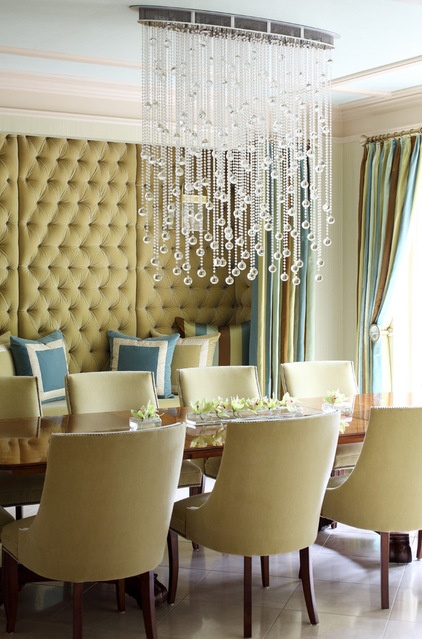
Wall upholstery evolved from medieval times when hung tapestries helped keep drafts at bay. Fixed wall upholstery was introduced in the 17th century when opulent fabrics became more readily available.
While upholstered walls help with insulation, today they’re primarily used for aesthetics and acoustics, either by enhancing sound within a room or muffling unwanted outside noise. To be clear, though, upholstered walls aren’t your everyday, run-of-the-mill sort of wall treatment. They’re something quite special.
If you’re considering upholstery to wrap an entire room, adorn a single wall or cover a simple niche, there are a few things you’ll want to consider in terms of cost, installation and more.
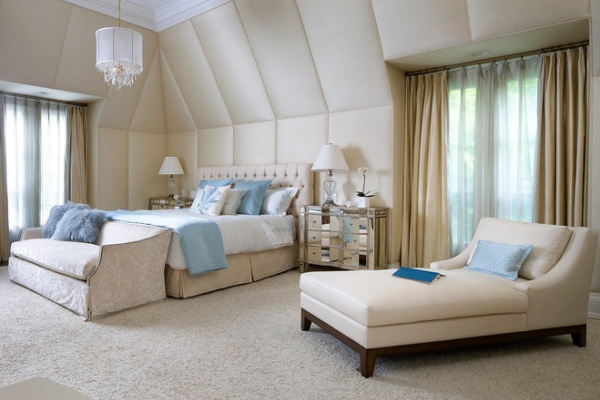
Scope of Project
Upholstering an entire room. In this bedroom design, the entire wall surface is devoted to padded upholstery. Instead of a continuous, smooth installation, there is repetition of form with a paneled look. The effect is striking. Reflected light subtly drawn across the fabric enhances the slight pillowing between the panels.
This type of installation requires a solid, textural fabric. A pattern, in addition to being overwhelming in such a large installation, would visually suppress the geometry of the panels.
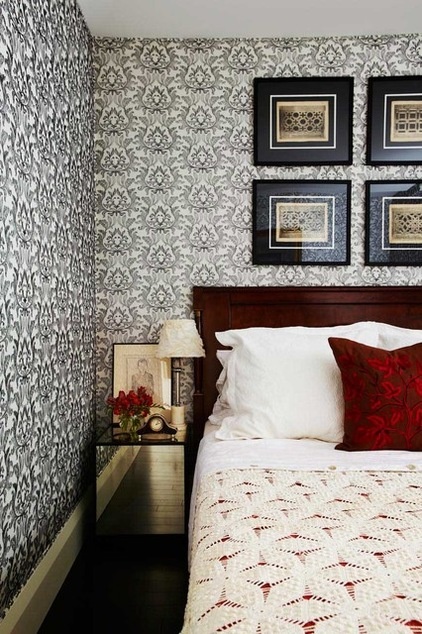
All four walls of this bedroom are upholstered in a fabric with a medium-scale print. The higher contrast (black and white) of this fabric makes it perfect for enveloping a smaller space.
If you’re considering a full-wall installation, be extra cautious about leaving a slight gap between furniture pieces, such as beds and nightstands, and the fabric wall surface, so as not to damage the fabric. Also, be careful when vacuuming, especially if your baseboard trim is shorter than your vacuum head. And be especially mindful when using candles.
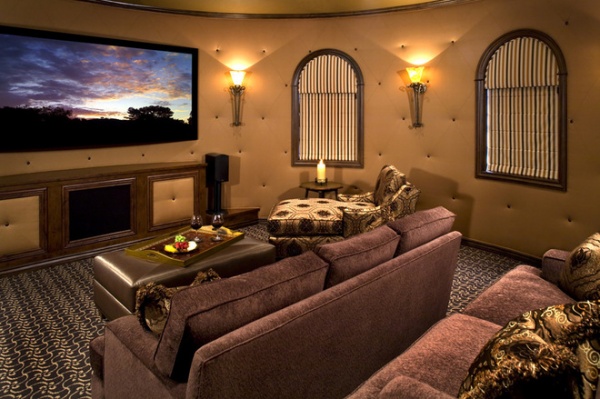
This round theater room is entirely upholstered to help absorb the noise from the media components.
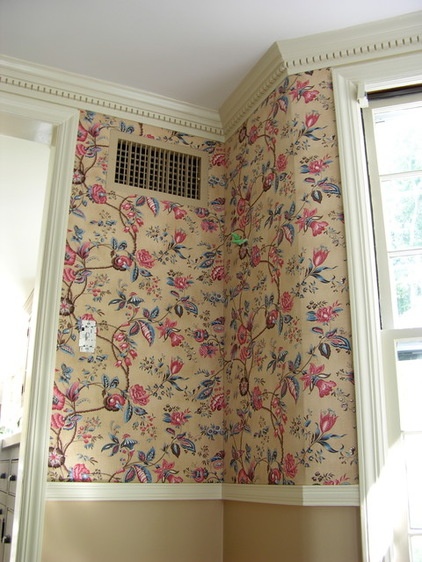
Upholstering a partial wall. Because upholstered walls are costlier than other wall treatments (see below for info on cost), many installations are done on just part of a wall, traditionally the upper half. Upholstered sections are framed by architectural trim. This dining room has a pretty floral fabric edged by a chair rail and crown molding.
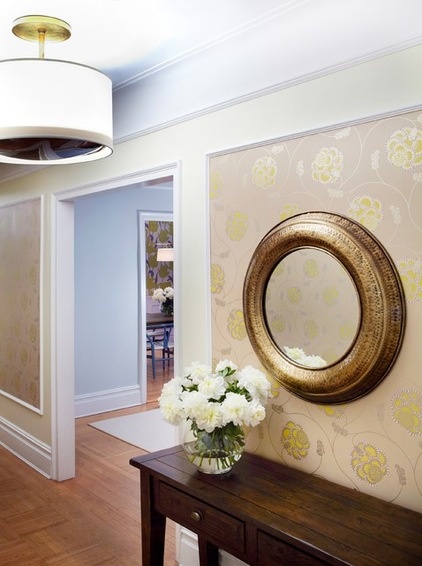
This corridor installation features upholstered panels framed by applied wood trim.
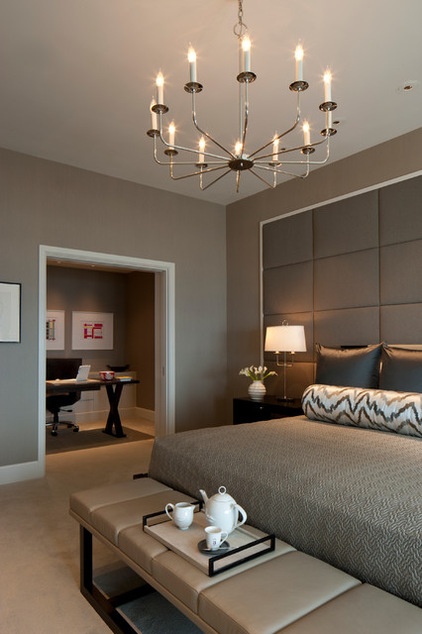
A dedicated bed zone can be created by upholstering a portion of the wall that is wide enough to encompass the bed and nightstands but does not engulf the entire wall. In this example a contrasting white trim sets off the upholstered section from the surrounding wall surface.
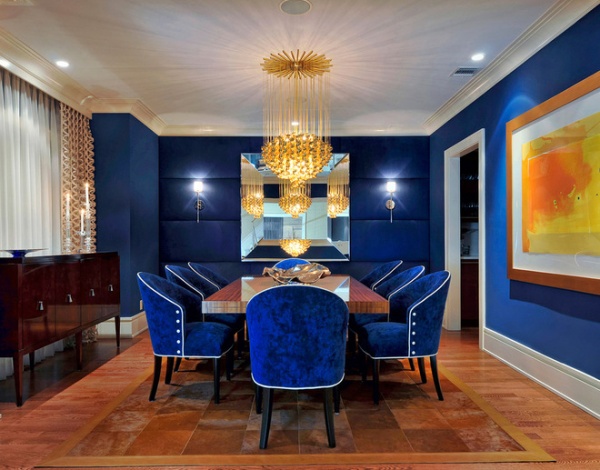
Upholstering a single wall or an inset niche. Many upholstered wall installations are done on an entire single feature wall instead of the whole room. Reasons vary from cost to aesthetics — too much fabric can sometimes be overpowering.
In the absence of any architectural wood framework, this approach creates a clean, sleek look.
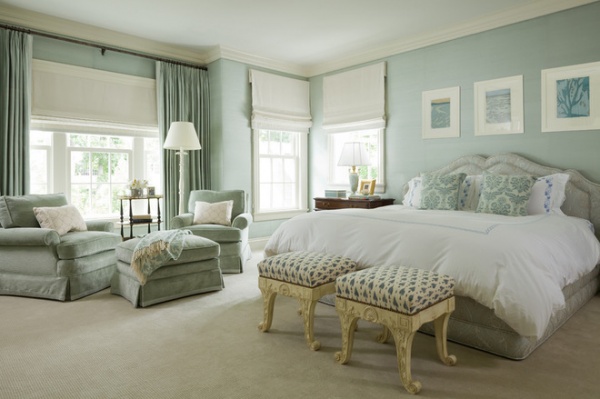
Design Considerations
Fabric type. For a full or partial wall installation that isn’t tufted, a light- to medium-weight fabric — such as silk, shown here, or cotton or linen — will work well. A heavy fabric will likely pull downward and droop. Silks can be backed for additional stability.
Heavy fabrics, such as velvets, are best used in applications where they are routinely anchored, such as a tufted installation.
Depending on where you live, local ordinances may require flame-retardant fabrics and batting or foam, so it’s best to check first.
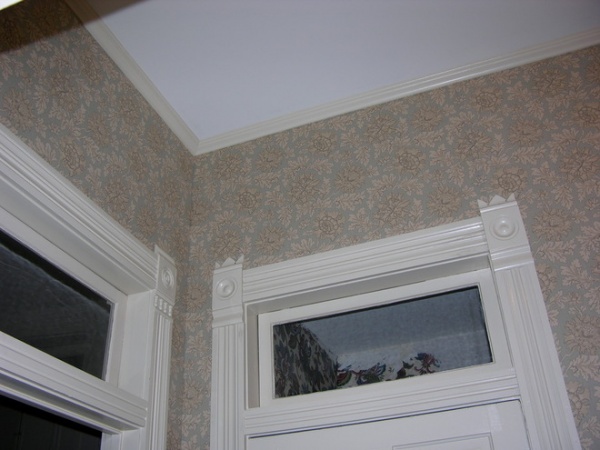
Pattern matching. Just like with wallpaper and furniture upholstery, the larger the pattern repeat, the greater the yardage requirement. If your heart is set on a patterned fabric, be prepared to spend more than for a solid fabric.
A good professional installer will match the pattern on the wall and corners so the fabric turns with the continuity of the pattern intact. The beautiful floral fabric installation shown here illustrates this point perfectly.
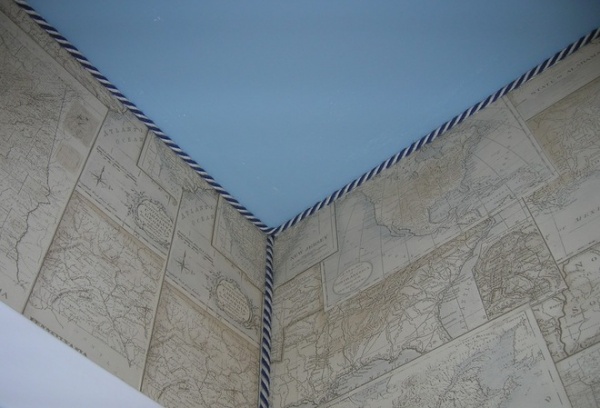
Trim or no trim? Depending on how your wall upholstery will be installed, you may have unsightly edges that need to be covered by a trim, such as the braid shown here. Another option is a self-welt made of the same fabric or a tape trim. A trim will add additional expense to the project.
While some people like the look of trim, others do not. Some installation methods incorporate a system that eliminates the need for any edge treatment (see the section on prefabricated frame systems below). It’s best to figure out what you like and your expectations beforehand.
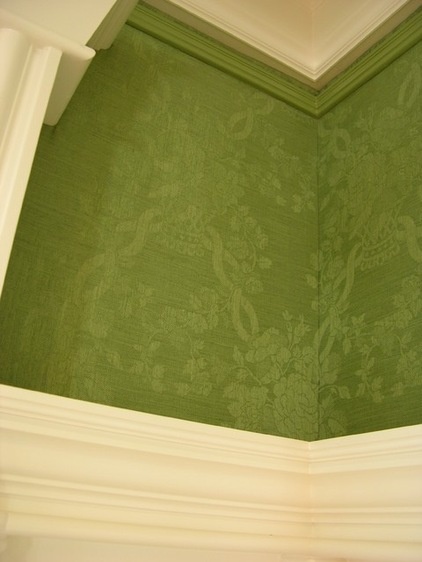
Hanging artwork. Do you really want to hammer a hole through your upholstered wall to hang a picture?
If you have the space, consider adding a picture rail on which to hang artwork before the project starts. The rail shown here was painted green to blend in with the green tone-on-tone damask walls.
If you can’t spring for a picture rail or don’t have room, choose your art pieces and hanging locations thoughtfully. Unlike with paint, there’s no patching up a hole in fabric.
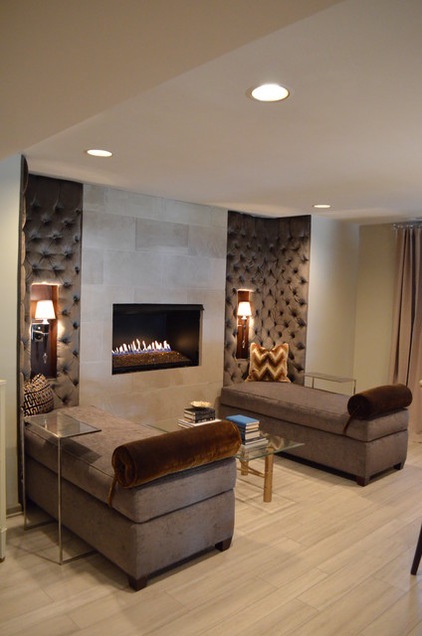
Methods of Upholstery Installation
Upholstered panels applied to wall. Designer Stacy Thompson of Compass Design designed the two upholstered wall sections shown here to double as a backrest for a couple of chaise longues.
She says it was a tricky installation because of the angled corner. She fabricated boards to attach the foam, batting and fabric to, then tufted the fabric. Screws attach the panels to the wall and are hidden behind the buttons in the tufting. To finish the raw edge, she used welting in the same fabric and glued it all the way around. Thomson says because of the complex installation, she would recommend hiring a professional for a project like this.
Good for you if …
You’re upholstering only a portion of a wall or a niche in a simple shape.Your upholstery design is composed of sections butted together.
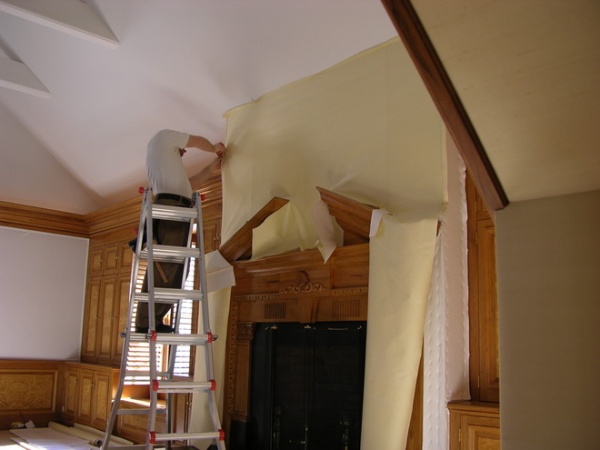
Prefabricated frame systems. Different installers use different systems. Veronique Thoman of V.E. Thoman says her company’s method uses a ¼-inch-thick clean-edge system (CES) frame that is anchored to the perimeter of the wall and around any trim, like on doors and windows. The frame tightly stretches the batting and fabric across the wall and holds it in place. In the image here, Eric Thoman is installing a light yellow fabric over a fireplace mantel.
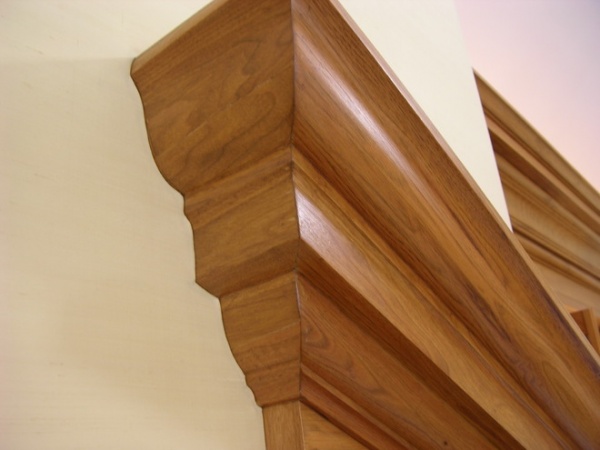
The primary advantage of this system is that it neatly finishes the edge of the fabric so there are no raw fabric edges or unsightly folds. It eliminates the need for any decorative edge trim.
Here is a detail shot of the completed installation introduced in the previous image. The wall upholstery is level and neat and doesn’t pucker at adjacent woodwork.
Good for you if …
You don’t want to use a decorative edge trim.You have complicated molding profiles.You’re upholstering an entire room, a single wall or an inset panel.
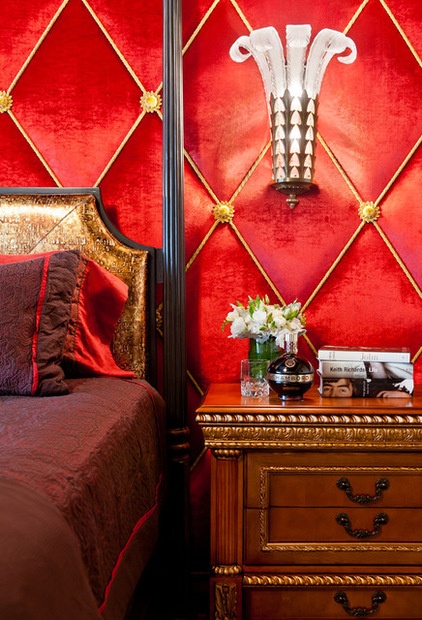
Constructed grid system. If diamonds make your heart race, then this approach may be right for you.
Similar to a tufted wall, this look has volume. The pillowed effect is created by tying down the fabric by a network of gold cord and rosettes. It creates a rich, luxurious presence — with an elegant nod to the past.
Designer Hilary Unger of Perianth Interior Design says this theatrical bedroom wall was constructed by first applying wood strips on the wall. Foam padding was then cut into each diamond, with just enough space between the foam and slats to accommodate the gold cord that would be applied later. The whole wall was then overlaid with a layer of Dacron batting. Lastly, the velvet was upholstered to the wall. The underlying foam diamonds telegraphed through to reveal the outline of the foam diamonds to guide where the gold cord and rosettes were to be anchored. The result is dramatic.
Good for you if …
You want to create a grid pattern with an applied trim. Diamonds or squares are superb shapes for this approach.You’re pursuing a full-wall or partial-wall installation.
Cost
The cost of upholstered walls can vary greatly; it’s largely dependent upon the cost of the fabric, the complexity of the project and the location.
Unger says the cost for her project shown here, completed by Distinctive Window Treatments Plus, ran about $90 per square foot, including the fabric, related materials and labor.
V.E. Thoman says an average full-room installation starts around $4,500 and includes the CES frame, padding and labor. The fabric is additional and supplied by the homeowner or designer.
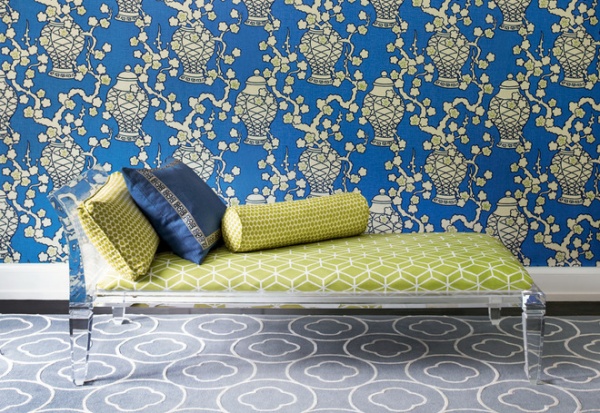
Maintenance
Dust is enemy No. 1 for upholstered walls. It sits on the face of the fabric and captures humidity and holds it against the fibers, accelerating deterioration. Lightly vacuuming the walls with a soft suction attachment is all you need to do for routine maintenance. Specialized wall upholstery cleaning companies can clean the walls more thoroughly.
More: How to Work With an Upholsterer
Related Articles Recommended












